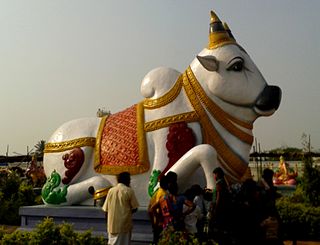Related Research Articles

Nut, also known by various other transcriptions, is the goddess of the sky, stars, cosmos, mothers, astronomy, and the universe in the ancient Egyptian religion. She was seen as a star-covered nude woman arching over the Earth, or as a cow. She was depicted wearing the water-pot sign (nw) that identifies her.

Hathor was a major goddess in ancient Egyptian religion who played a wide variety of roles. As a sky deity, she was the mother or consort of the sky god Horus and the sun god Ra, both of whom were connected with kingship, and thus she was the symbolic mother of their earthly representatives, the pharaohs. She was one of several goddesses who acted as the Eye of Ra, Ra's feminine counterpart, and in this form she had a vengeful aspect that protected him from his enemies. Her beneficent side represented music, dance, joy, love, sexuality, and maternal care, and she acted as the consort of several male deities and the mother of their sons. These two aspects of the goddess exemplified the Egyptian conception of femininity. Hathor crossed boundaries between worlds, helping deceased souls in the transition to the afterlife.
The Tumbuka are an ethnic group living in Malawi, Zambia, and Tanzania. In Tumbuka mythology, Chiuta is the Supreme Creator and is symbolised in the sky by the rainbow.
Adroa is the supreme god or spirit of the Lugbara people of central Africa.

Animal worship is an umbrella term designating religious or ritual practices involving animals. This includes the worship of animal deities or animal sacrifice. An animal 'cult' is formed when a species is taken to represent a religious figure. Animal cults can be classified according to their formal features or by their symbolic content.

Philippine mythology is rooted in the many indigenous Philippine folk religions. Philippine mythology exhibits influence from Indonesian, Hindu, Muslim, Shinto, Buddhist, and Christian traditions.

The sky often has important religious significance. Many religions, both polytheistic and monotheistic, have deities associated with the sky.

Asase Ya/Afua is the Akan goddess of fertility, love, procreation, peace, truth and the dry and lush earth in Ghana and Ivory Coast. She is also Mother of the Dead known as Mother Earth or Aberewaa.

Egyptian mythology is the collection of myths from ancient Egypt, which describe the actions of the Egyptian gods as a means of understanding the world around them. The beliefs that these myths express are an important part of ancient Egyptian religion. Myths appear frequently in Egyptian writings and art, particularly in short stories and in religious material such as hymns, ritual texts, funerary texts, and temple decoration. These sources rarely contain a complete account of a myth and often describe only brief fragments.

Akan religion comprises the traditional beliefs and religious practices of the Akan people of Ghana and eastern Ivory Coast. Akan religion is referred to as Akom. Although most Akan people have identified as Christians since the early 20th century, Akan religion remains practiced by some and is often syncretized with Christianity. The Akan have many subgroups, so the religion varies greatly by region and subgroup. Similar to other traditional religions of West and Central Africa such as West African Vodun, Yoruba religion, or Odinani, Akan cosmology consists of a senior god who generally does not interact with humans and many gods who assist humans.
Mbombo, also called Bumba, is the creator god in the religion and mythology of the Kuba people of Central Africa in the area that is now known as Democratic Republic of the Congo. In the Mbombo creation myth, Mbombo was a giant in form and white in color. The myth describes the creation of the universe from nothing.
Ajok, also known as Adyok and Naijok in certain variations, is the supreme deity in Lotuko mythology, who created humans as a mirror image of himself.
Kalumba, also known as Sendwe Mwlaba, is the supreme god figure worshipped by the Luba people of the Democratic Republic of Congo.
Kuoth, also known as Kuoth Nhial, is in African mythology the supreme omnipresent god and creation god of the Nuer people of South Sudan and Gambella.
Ngewo is the supreme creator god of the people of Mende from Sierra Leone.
Nhialic is the supreme creator god of the Dinka pantheon, whose people now dwell in South Sudan. When used in the context of Dinka language, the term also can refer to the entirety of the gods within the Dinka pantheon. In some accounts, Nhialic is also known as Deng Dit.
References
- 1 2 Lynch, Patricia Ann; Roberts, Jeremy (2010). African Mythology, A to Z. Infobase Publishing. ISBN 978-1-4381-3133-7.
- ↑ Hollis, Susan Tower (1998). "Otiose Deities and the Ancient Egyptian Pantheon" . Journal of the American Research Center in Egypt. 35: 61–72. doi:10.2307/40000461. ISSN 0065-9991. JSTOR 40000461.
- ↑ "Wulbari". Oxford Reference. Retrieved 2021-05-13.
- 1 2 "Wulbari and the Bird That Liked Human Flesh". Oxford Reference. Retrieved 2021-05-13.